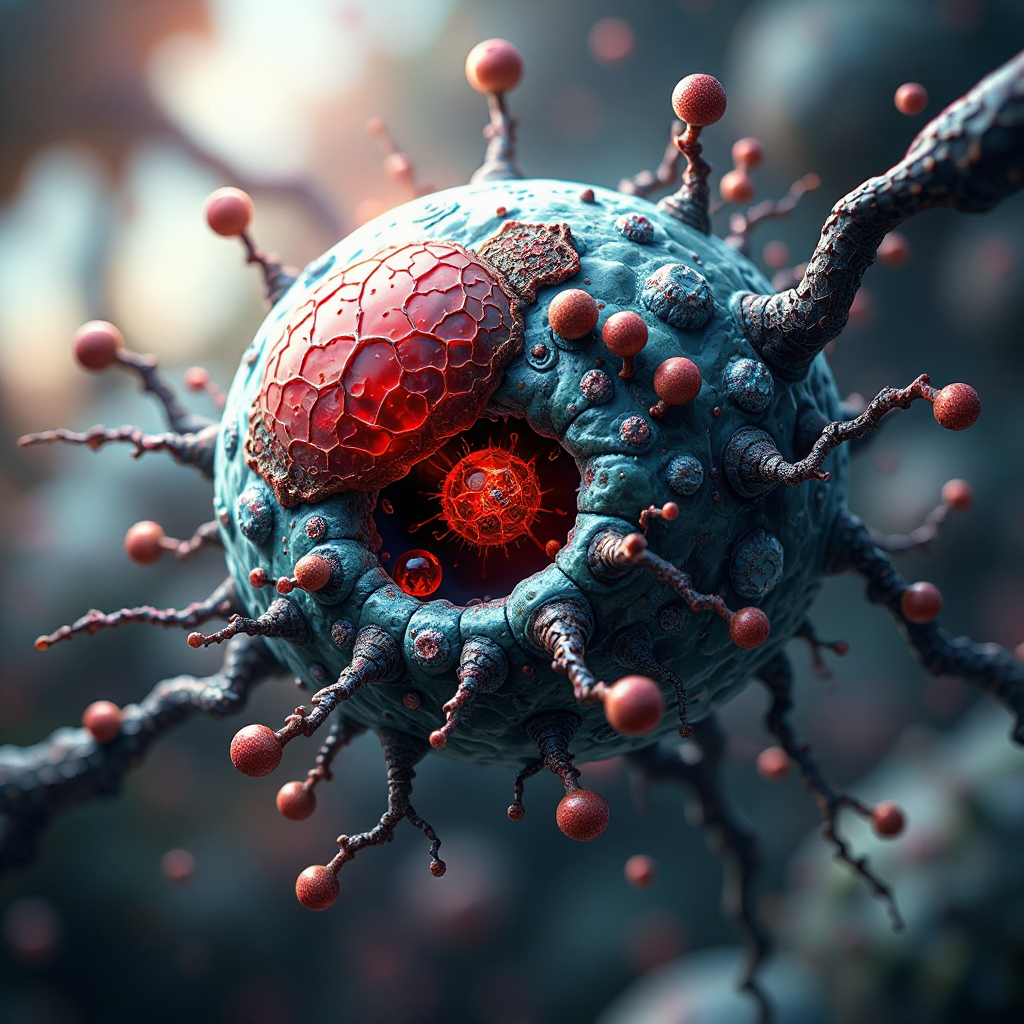Understanding Skin Adnexal Tumors and Their Types

Skin adnexal tumors, including types such as sebaceous carcinoma, are abnormal growths originating from the skin's appendages, like hair follicles, sebaceous glands, and sweat glands. These tumors are relatively uncommon, with a global age-adjusted incidence of about 5.1 cases per million person-years. The majority of these tumors are benign, making up 82.73% of cases, while 17.27% are malignant. Malignant tumors, such as sebaceous carcinoma, often grow quickly, have irregular appearances, and may ulcerate. Prompt and accurate diagnosis is essential, as certain types, like sebaceous carcinoma, can behave aggressively and pose serious health risks.
Key Takeaways
Skin adnexal tumors can be harmless or harmful. Most are harmless. Knowing the difference helps treat them better.
Finding skin adnexal tumors early is very important. It saves lives and avoids problems. See a doctor for strange skin growths.
Sebaceous carcinoma is a harmful skin tumor that can spread. Knowing it is serious helps start treatment quickly.
Some genetic problems, like Muir-Torre Syndrome, raise tumor risks. Knowing this helps with better checks and care.
Regular check-ups after treatment are very important. They help find new tumors and keep you healthy.
What Are Skin Adnexal Tumors?
Definition and Overview
Skin adnexal tumors are abnormal growths that originate from the skin's appendages. These appendages include hair follicles, sebaceous glands, and eccrine and apocrine sweat glands. These tumors can be benign or malignant and may develop sporadically or as part of genetic syndromes like Birt-Hogg-Dube or Brooke-Spiegler syndrome. Diagnosis often relies on a combination of clinical examination and histopathological analysis.
Characteristics of Skin Adnexal Tumors
Benign vs. Malignant Tumors
Benign skin adnexal tumors grow slowly and rarely spread to other parts of the body. They often present as small, painless nodules. Malignant tumors, such as sebaceous carcinoma, tend to grow rapidly and may ulcerate or invade surrounding tissues. Histologically, benign tumors often show well-differentiated structures resembling normal skin appendages, while malignant tumors exhibit cellular atypia and invasive growth patterns.
Clinical Presentation and Symptoms
Skin adnexal tumors commonly appear as nodules or plaques on the skin. The head and neck region accounts for the majority of cases, with 63.64% of tumors occurring in these areas. Tumors of follicular origin are the most frequent, followed by eccrine and sebaceous tumors. Some malignant tumors, like microcystic adnexal carcinoma, may present as firm, flesh-colored plaques with infiltrative edges, leading to local recurrence if not treated promptly.
Importance of Early Detection
Risk of Malignancy
Early detection of skin adnexal tumors significantly improves outcomes. Patients diagnosed at an early stage often experience better overall survival and recurrence-free survival rates. The absence of nodal metastasis is another factor that correlates with improved disease-specific survival. Advanced stages, however, are associated with poorer outcomes, highlighting the importance of timely diagnosis.
Syndromic Associations (e.g., Muir-Torre Syndrome)
Some skin adnexal tumors, particularly sebaceous carcinoma, may be linked to syndromes like Muir-Torre Syndrome. This condition is associated with a genetic predisposition to sebaceous tumors and internal malignancies. Identifying these syndromic associations can guide further screening and management, ensuring comprehensive care for affected individuals.
Types of Skin Adnexal Tumors

Sebaceous Tumors
Sebaceous Adenoma
Sebaceous adenomas are benign tumors arising from sebaceous glands. These growths typically appear as small, yellowish nodules on the face or scalp. They are slow-growing and rarely cause discomfort. Histologically, sebaceous adenomas display well-differentiated sebaceous cells with minimal atypia. Although benign, their presence may sometimes indicate an underlying genetic syndrome, such as Muir-Torre Syndrome.
Sebaceous Carcinoma
Sebaceous carcinoma is a malignant tumor with aggressive behavior. It often develops on the eyelids but can also occur on other parts of the body. This tumor grows rapidly and may ulcerate or invade nearby tissues. Histopathological analysis reveals cellular atypia, mitotic activity, and infiltrative growth patterns. Early detection is crucial, as sebaceous carcinoma has metastatic potential and may be associated with syndromes like Muir-Torre Syndrome.
Sweat Gland Tumors
Eccrine Tumors
Eccrine tumors originate from sweat glands and can be benign or malignant. Benign forms, such as eccrine spiradenoma, exhibit architectural similarities to normal sweat glands. Malignant eccrine tumors, like porocarcinoma, show duct formation, cytologic atypia, and brisk mitotic activity. These tumors often present as nodules or plaques on the skin.
Apocrine Tumors
Apocrine tumors arise from apocrine sweat glands, commonly found in the axillae or groin. Benign apocrine tumors, such as apocrine hidrocystomas, are cystic and non-invasive. Malignant types, like hidradenocarcinoma, exhibit infiltrative growth and marked nuclear atypia. These tumors may cause discomfort or ulceration if left untreated.
Note: Sweat gland tumors, whether eccrine or apocrine, require histopathological analysis for accurate diagnosis due to their overlapping clinical features.
Hair Follicle Tumors
Pilomatricoma
Pilomatricoma is a benign tumor derived from hair follicle matrix cells. It presents as a firm, subcutaneous nodule, often on the head, neck, or upper extremities. Diagnosis relies on clinical examination and histopathology, which reveals basaloid cells and shadow cells.
Trichoblastoma
Trichoblastoma is another benign tumor originating from hair follicles. It typically appears as a slow-growing nodule on the scalp or face. Histologically, it resembles basal cell carcinoma but lacks invasive features. Other benign hair follicle tumors include trichoepithelioma and fibrofolliculoma, which share similar clinical presentations.
Tip: Hair follicle tumors, including pilomatricoma and trichoblastoma, are usually benign but may mimic malignant lesions. Accurate diagnosis is essential to avoid unnecessary treatments.
Sebaceous Carcinoma: A Closer Look

Characteristics of Sebaceous Carcinoma
Aggressive Nature and Metastatic Potential
Sebaceous carcinoma is a rare but highly malignant tumor that arises from sebaceous glands. It has a significant risk of metastasis, with approximately 25% of cases spreading to other parts of the body. Periocular sebaceous carcinomas, which account for about 75% of cases, are particularly aggressive. These tumors often mimic other skin cancers, making diagnosis challenging. The presence of TP53 mutations suggests a unique pathogenesis, contributing to its aggressive behavior. Solitary cases of sebaceous carcinoma tend to be more malignant compared to those associated with syndromes like Muir-Torre Syndrome.
Common Sites of Occurrence
Sebaceous carcinoma most commonly develops in the eyelids, particularly in the upper eyelid, due to the high concentration of sebaceous glands in this area. About 25% of cases occur in extraocular locations, including the head, neck, and areas with hair, such as the genital region. Rarely, these tumors may also appear in the ear canal, breasts, trunk, or oral cavity.
Risk Factors and Syndromic Links
Muir-Torre Syndrome
Muir-Torre Syndrome (MTS) is a genetic condition linked to sebaceous carcinoma. Approximately 24% of individuals with MTS develop sebaceous carcinoma. Tumors associated with MTS are generally less aggressive and less likely to metastasize compared to solitary cases. Identifying this syndrome is crucial for guiding further screening and management.
Genetic Predispositions
Genetic mutations, such as those affecting DNA mismatch repair genes, play a significant role in the development of sebaceous carcinoma. These mutations are often seen in patients with MTS. Additionally, TP53 mutations have been implicated in the pathogenesis of more aggressive forms of the tumor.
Diagnosis and Treatment
Diagnostic Techniques
Accurate diagnosis of sebaceous carcinoma requires a high index of suspicion. Physical examination, including eversion of the eyelid to inspect for lesions, is essential. Diagnostic procedures include:
Wide excisional biopsy to confirm malignancy.
Mapping biopsies of the conjunctiva to assess the extent of the tumor.
Treatment Options
Radical surgical excision remains the most effective treatment for sebaceous carcinoma. Mohs micrographic surgery is often recommended for precise margin control. Radiation therapy serves as an alternative for patients who cannot undergo surgery. Early detection and treatment improve prognosis, but regular follow-up is necessary due to the risk of recurrence.
Diagnosis and Management of Skin Adnexal Tumors
Diagnostic Approaches
Clinical Examination
Clinical examination plays a vital role in the initial assessment of skin adnexal tumors. Physicians evaluate the lesion's size, shape, color, and texture. They also check for signs of ulceration, rapid growth, or invasion into surrounding tissues. A thorough examination of the head and neck region is essential, as most skin adnexal tumors, including sebaceous carcinoma, occur in these areas. Palpation helps determine the lesion's depth and mobility, which can provide clues about its nature.
Histopathological Analysis
Histopathological analysis remains the gold standard for diagnosing skin adnexal tumors. This method involves examining tissue samples under a microscope to identify architectural and cellular features. Pathologists use hematoxylin-eosin (H&E) staining to classify tumors based on their resemblance to sebaceous glands, sweat glands, or hair follicles. Sebaceous proliferations are ruled out first due to their distinct characteristics. If sebaceous features are absent, sweat duct formation is assessed, followed by hair follicle differentiation. This systematic approach ensures accurate classification, which is critical for determining the appropriate treatment.
Treatment Strategies
Surgical Excision
Surgical excision is the primary treatment for most skin adnexal tumors. Complete resection with clear margins is crucial, especially for malignant tumors like sebaceous carcinoma. Mohs micrographic surgery is often preferred for its precision in removing cancerous tissue while preserving healthy skin. This technique minimizes recurrence rates and improves cosmetic outcomes.
Adjuvant Therapies
Adjuvant therapies, such as radiation and chemotherapy, are considered when surgical margins are inadequate or when tumors recur. Radiation therapy is particularly beneficial for patients who cannot undergo surgery. Chemotherapy is reserved for advanced cases, with agents like cisplatin and paclitaxel showing varying degrees of effectiveness. The role of adjuvant therapies continues to evolve, with ongoing research exploring their potential benefits.
Prognosis and Follow-Up
Factors Influencing Prognosis
Several factors influence the prognosis of patients with skin adnexal tumors. Advanced T stage is a significant predictor of poor recurrence-free survival. However, histologic grade does not appear to affect overall survival or disease-specific survival. Treatment modalities, including surgery and adjuvant therapies, also play a crucial role in determining outcomes.
Importance of Regular Monitoring
Regular follow-up is essential for patients with skin adnexal tumors, particularly those with malignant forms. Monitoring helps detect recurrences early and ensures timely intervention. Physicians typically recommend periodic clinical examinations and imaging studies to track the patient's progress. Consistent follow-up improves long-term survival and quality of life.
Skin adnexal tumors, including benign types like trichoblastoma and malignant forms such as sebaceous carcinoma, hold significant clinical importance. These tumors are classified based on their potential for malignancy. Benign tumors often require minimal intervention unless their diagnosis is uncertain. Malignant cases, though rare, can lead to severe conditions like trichoblastic carcinoma.
Early detection plays a vital role in managing these tumors effectively. Prompt diagnosis and treatment improve patient outcomes and reduce the risk of complications. Individuals noticing unusual skin growths should consult a healthcare professional without delay. Seeking timely medical advice ensures proper care and peace of mind.
FAQ
What are the common symptoms of skin adnexal tumors?
Skin adnexal tumors often appear as nodules, plaques, or lumps on the skin. These growths may be painless or tender. Malignant tumors can grow rapidly, ulcerate, or invade nearby tissues.
Tip: Any unusual skin growth should be evaluated by a healthcare professional for accurate diagnosis.
Are skin adnexal tumors always cancerous?
No, most skin adnexal tumors are benign. However, some, like sebaceous carcinoma, are malignant and require prompt treatment. Early detection helps differentiate between benign and malignant types.
How are skin adnexal tumors diagnosed?
Doctors use clinical examinations and histopathological analysis to diagnose these tumors. A biopsy provides detailed information about the tumor's origin and nature.
Note: Accurate diagnosis ensures appropriate treatment and better outcomes.
Can genetic factors increase the risk of skin adnexal tumors?
Yes, genetic syndromes like Muir-Torre Syndrome and mutations in DNA mismatch repair genes can increase the risk. These conditions often link to sebaceous tumors and other malignancies.
What is the best treatment for malignant skin adnexal tumors?
Surgical excision, including Mohs micrographic surgery, is the most effective treatment. Radiation therapy may be used for patients unable to undergo surgery.
Reminder: Regular follow-ups are essential to monitor for recurrence or complications.
See Also
Exploring Gestational Trophoblastic Tumors And Their Varieties
Recognizing Signs And Therapies For Adrenocortical Adenoma
Defining Extragonadal Germ Cell Tumors And Their Formation
